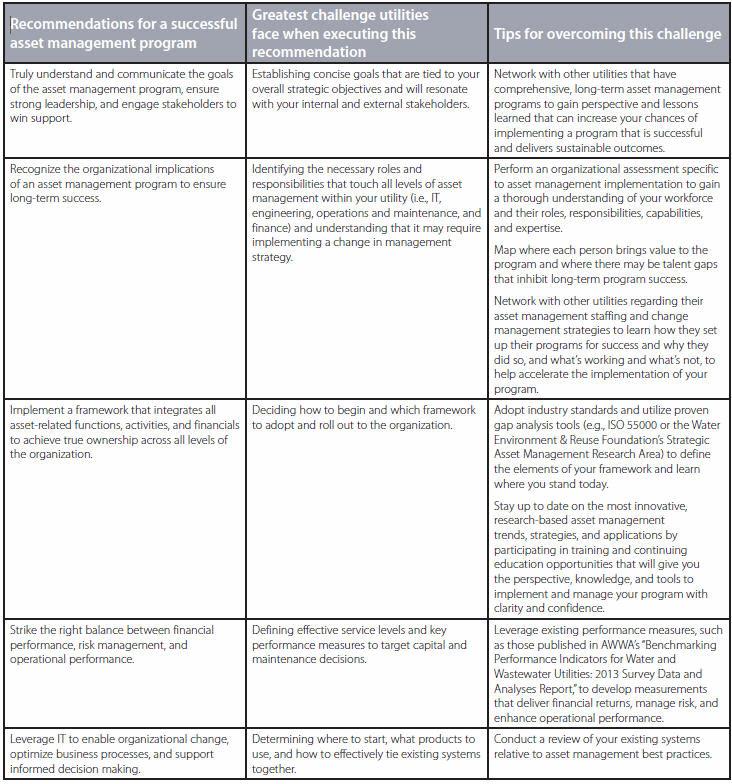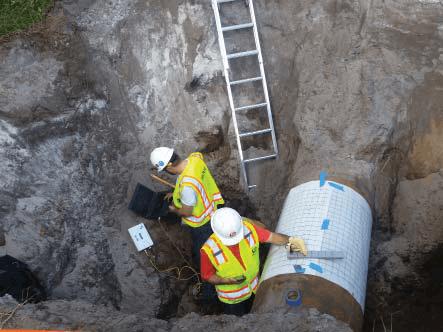Identifying Risks For Sewer Conveyance Asset Management
By Celine Hyer
If risk analysis isn’t in the pipeline, your asset management plan needs updating. Arcadis shares best practices to launch or update your program.
Done right, asset management delivers savings, risk reductions, and efficiency. But getting there involves important trade-offs and decisions with serious financial and service implications.
We will explore ways that utilities can identify the most critical and vulnerable risk points, even in enormous and complex systems, and use this information to tackle rehabilitation and replacement while making a solid case for funding.
Given the substantial effort and cost of renewing sewer conveyance systems, especially those nearing the end of their economic and service lives, it helps to be able to make the case that any investment should have maximum effect. Therefore, every program should start by determining the best approach for everything, from overall asset management to risk-based pipe replacement.
Reframing The Approach To Asset Management
Effective asset management is crucial to ensuring the right work is done at the right time. Using outdated or incorrect approaches can result in underperformance and loss. Fortunately, we are in the midst of an asset management revolution, opening avenues to improved planning, budgeting, and efficiency.
No longer solely a technical discipline primarily driven by the need to improve capital investment forecasting, today’s business-driven mindset considers the entire asset life cycle, inherently transforming the way utilities operate. In fact, utilities that can break the functional silos can create a plan that is truly sustainable, now and across the life of the whole water or wastewater system.
But getting such an enterprising program off the ground starts with single steps. It helps to identify first the elements of the program that can jumpstart the desired changes, while recognizing that the data required to fully realize the benefits may not be available right away. Taken from the Arcadis paper “Improving the Current State of Water and Wastewater Buried Infrastructure for a More Sustainable Future,” the following list of five critical elements of a successful asset management program can help anticipate and overcome the inevitable challenges.
Expert Resource: The Virginia Tech Sustainable Water Infrastructure Management (SWIM) Center — Blacksburg, VA
The SWIM Center was created to help utilities build asset management programs rooted in research, innovation, and practicality, with access to a network of expert professionals. Knowledge centers like the SWIM Center have been proven to provide a foundation of needed industry data, training, and best practices to advance asset management programs.
Tapping into the SWIM Center lets utilities create and share infrastructure data, tools, and cases to set asset management programs in a positive direction. It also offers the most comprehensive source of water infrastructure asset management information and innovative research available through the PIPEiD and WATERiD national databases, conferences, workshops, training courses, publications and reports, and SWIMeD online certification programs.
However important, these are foundational activities for the main event: assessment and risk analysis for rehabilitation and replacement planning.
Sewer Pipe Condition Assessment For Rehabilitation And Replacement Planning – New Castle County, DE
Arcadis developed an asset management program to identify the nature, extent, and sources of infiltration and inflow (I/I), cross-connections, and structural failures for New Castle County, DE. This provided valuable information to set priorities and budgets for a program of capacity, management, operations, and maintenance (CMOM); replacement; and expansion.
Five Recommendations For Successful Asset Management

New Castle County owns and operates wastewater collection and conveyance facilities comprising about 1,600 miles of gravity sewer and interceptors, 40,000 manholes, and more than 150 pump stations. This also includes the Brandywine Hundred Sewer System, encompassing four sewersheds with more than 420 miles of the oldest and most problematic sewers, located in some of the county’s most densely populated areas. The system includes a number of structured sanitary sewer overflows (SSOs) that combine untreated sewage with stormwater for discharge in the Delaware River and tributaries. The Brandywine Hundred Sewer System Rehabilitation and Capacity Assurance Program aimed to:
- reduce groundwater and rainwater entry from I/I into the collection system to achieve a significant reduction in basement sewage backups, the occurrence of hydraulics-related sanitary SSOs, and interceptor surcharges; and
- reduce infrastructure failures that contribute to combined sewer overflows (CSOs) and SSOs.
The program included:
- hydraulic condition assessment, data review, and modeling to understand the extent and nature of chronic problem areas
- physical condition assessment, using CCTV, polemounted zoom camera inspections, and sanitary sewer evaluation technology
- smoke testing and basement sump inspections to identify inflow contributions in each subbasin, subsequently used to develop a program to reduce illicit connections
- sewer modeling to determine existing level of control and needed I/I removal requirements for regulatory compliance
- maintenance and inspection program development.

Condition assessment of a sewer force main using broadband electromagnetic technology to measure the pipe wall thickness
The rehabilitation and prioritization work helped identify, budget, and frame a capital plan for replacement, expansion, and clearwater elimination projects implemented in three phases over 15 years. As of 2017, much of the Phase 1 work is complete.
Planning For Sewer Conveyance Damaged By Hurricanes In Florida
Risk assessment has been critical for a sewer rehabilitation and replacement program for the Emerald Coast Utilities Authority (ECUA) in Florida. The system serves almost 300,000 people in Escambia County and the City of Pensacola, with 915 miles of gravity sewer and three wastewater treatment plants with a total combined permitted capacity of 33 MGD. Damage from Hurricane Ivan in 2004 had significantly increased I/I flows the years following. The risk assessment is helping to determine priorities and set the agenda for future work.
To ground this comprehensive sewer rehabilitation program with actionable information, Arcadis conducted extensive data collection, including covered flow metering studies and sewer system evaluation surveys (SSESs) of 207 miles of gravity sewers in four major project areas. The flow metering included 12 long-term flow meters, four rain gauges, and 31 short-term meters. Smoke testing for cross connections and nighttime flow measurements using V-notch weirs to evaluate groundwater infiltration was completed in September 2009. A total of 1,500 manholes have been inspected to date. Initial CCTV investigations were completed in mid-2008.
The hydraulic and physical condition assessments identified key areas of sewer rehabilitation needed for 21 miles of sewer damaged by hurricanes. Because this sector experienced the most serious problems with I/I flows in the service area, this rehabilitation construction work was completed first. Other work includes open-cut replacement of sewer mains and laterals as well as cured-in-place lining. Through investigative processes, it was found that in some areas more than half of the existing laterals were determined to be inactive and have been eliminated from the system, thus reducing both potential inflow and groundwater infiltration.
Program tasks are accomplished through flow metering networks, nighttime weiring, above-grade storm inflow observations, smoke testing, and in-pipeline inspections using digital, state-of-the-art CCTV. The resulting information has been incorporated into the hydraulic model. As the program progresses, the entire service area will be prioritized for rehabilitation based on the size of the contribution of I/I, the anticipated failure period, and other criteria.
A related phase of the project includes the evaluation of the condition and risk of failure of the force mains. Condition assessments such as transient pressure monitoring, in-pipe inspection, and other nondestructive techniques are being used to evaluate the current conditions and make recommendations regarding replacement needs.
Risk-based planning brings down the total cost of sewer pipe rehabilitation and replacement. Integrating this work with asset management across the whole system for the complete asset life cycle will pay off many times over the years. But starting from a base of knowledge and using industry resources will help make the most of all needed risk assessment and possibly reduce the effort needed to identify critical weak points. The assessment then becomes a powerful data set to drive funding, planning, and execution.
About The Author
 Celine Hyer, senior vice president and conveyance lead at Arcadis North America, is a recognized expert in advanced rehabilitation and replacement planning for pipelines as well as treatment and pumping facilities, with over 17 years leading the implementation of asset management programs nationwide.
Celine Hyer, senior vice president and conveyance lead at Arcadis North America, is a recognized expert in advanced rehabilitation and replacement planning for pipelines as well as treatment and pumping facilities, with over 17 years leading the implementation of asset management programs nationwide.
